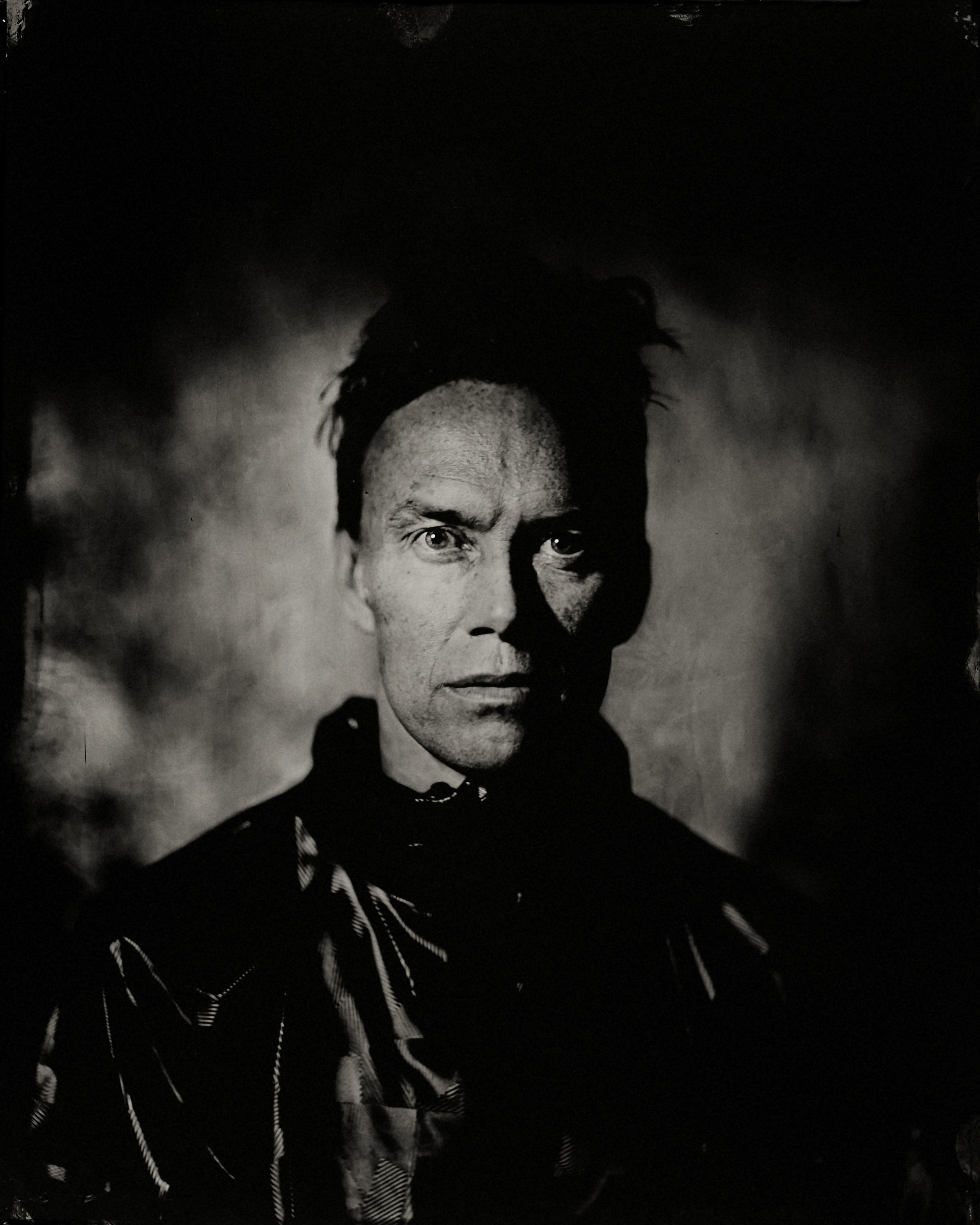Meet photographer, Søren Solkær as he gets his portrait taken by photojournalist Jan Grarup – using one of the most unfiltered and direct photographic methods out there.
Craft Matters: Innovators
Søren Solkær
We spent a day with photographer, Søren Solkær as he had his portrait taken by photojournalist Jan Grarup, and talked about photography, collaboration and how to get close to people.
| CONTRIBUTORS |
| Photos: Jan Grarup |
| Words: Nate Budzinski |
“Man, don’t bother taking your shoes off – this is a house with a bunch of teenagers living in it!” The Danish photographer Jan Grarup says as he welcomes me into his Copenhagen flat in the Østerbro district. “You want a coffee?” Grarup shouts from the kitchen, just around the corner from the entrance to his flat. In front of me on the wall is a portrait of a woman. Black and white and beautifully blurred as if a spirit emerging out of the picture frame, the photograph’s subject is both enigmatically self-contained as well as almost confrontational. “That’s a picture I took of my friend Patti Smith” Grarup later tells me, casually mentioning the legendary songwriter and poet.
I’m visiting Grarup’s home at the ask of another well-known Danish photographer, Søren Solkær. The two men were born a year apart (Grarup in 1968, Solkær in 69) and though they are part of defining their generation’s photography, they have yet to meet.
On the surface, the two image-makers might seem a world apart: Grarup has spent his career as a photojournalist covering some of the most war-torn countries from the 1990s to present, including Sierra Leone, Chechnya, Rwanda, Kosovo, Iraq and more. Solkær, on the other hand has pursued another seminal genre of photography: portraiture – specifically making images of leading musicians like Amy Winehouse, Björk, The White Stripes, Franz Ferdinand, R.E.M. and others. Both photographers are relaxed and easy; Jan with a laid-back intensity and Søren with a calm insistence – both personal qualities that probably benefit them in their respective field of photography.
This morning, we’re in Østerbro to have Grarup take a portrait of Solkær. Søren arrives a few minutes after me and we sit down to speak about the plan for the day. Immediately the two start discussing photography, specifically Jan’s digital Leica rangefinder camera, and quickly start to disappear down a rabbit-hole into their shared passion and profession.
“ Søren: “I haven’t had a portrait taken in about 15 years…”
Jan: “It’s about time!””
But it’s after we make our way up to Jan’s attic studio space that the real mind-meld happens. Søren specifically wanted his portrait to be shot by Jan as the latter has, alongside his photojournalism, been refining his skills in wet-plate photography. One of the earliest methods of photography, wet-plate was the 19th century version of digital image-making. Quicker and more economic than previous processes, wet-plate required a large light-sealed view camera unit, heavy tripod, and if all that wasn’t enough, a darkroom immediately nearby – many of which were adapted as large sheds on horse-drawn carts to function in a truly portable fashion.
Søren takes a seat arranged in front of a dappled drop sheet hung haphazardly across a wall as Jan goes to work setting up one of the massive, ancient looking wood and billows cameras he has placed about the studio floor. After exposing one plate, we head into Jan’s darkroom. He puts the plate into a tray of chemicals and we watch as an image of Søren slowly, almost magically, appears out of a chemical fog. “I haven’t had a portrait taken in about 15 years…” says Søren. “It’s about time!” Jan quips back. Over a few more exposures the conversation covers their recent and forthcoming exhibitions, books and star-photographer-friends-in-common, a fast catching-up that could only happen between two artists who share a medium and similar career trajectories.
After, we head over to Søren’s basement studio in Vesterbro on the other side of Copenhagen. We buy some sandwiches at a nearby cafe then make our way past a record shop, Søren saying hello to several locals passing us by. Over lunch we discuss Solkær’s start as a photographer: “I didn’t have a real camera until I was about twenty, and I didn’t study photography until I was twenty-four, so I started pretty late.” Solkær relates, describing his early years studying photography in Prague in the Czech Republic – known for its classical photography education with an emphasis on theatricality and staging the pictures – an element that has continued through Solkær's work. “I don’t know exactly why I bought a camera, but it was definitely my instinct to just start approaching people and ask if I could photograph them… it was an ice-breaker, also a way of being brave. I would have never gone up to these people and just talked with them. But I would with a camera.”
This was well over 20 years ago when Solkær was backpacking through Asia and elsewhere – indeed, he still has the photos he took then. “After some years, it turned out that I was focused on photographing creative people. Most of my projects have been about visual artists, directors, musicians. But my first big project was photographing photographers in the style of their own photography…” referring to his Photographers Posed series.
“It’s all about getting people to dare to be themselves, or to perform what they want…”
From there Søren continued with portraiture but moving into some of his most well-known work taking pictures of musicians. “In a way it’s still the same”, he continues, “they’re still people for the most part I find fascinating. I’m interested in anything artistic, and that (photography) is a way for me to get close to it. Like working with Jan earlier today – I was really interested to get close to how he works, and his process. It’s because he’s so experienced, there’s very little direction. Also, it’s quite collaborative, and I think I’m the same, in many ways. I also try to leave a space for creative expression… It’s all about getting people to dare to be themselves, or to perform what they want… Of course, when there’s a camera present, there’s always a level of fiction to what is happening, a level of performance.”
I ask Søren what it was like to be on the other side of the lens earlier in the day? “It was interesting to be photographed… It’s a very conscious effort – I do the same job as him so I know what’s going on!” Søren laughs. Was it like giving up control, I ask? “No, actually I felt a high level of control” Søren laughs again. “But I think that was down to Jan’s decisions. He could have gone into the darkroom without us, for instance, but he allowed me to chose my expression… by allowing me into the darkroom, he allowed me a lot of say.”






We finish just as Jan arrives to meet and shoot some more, this time in Søren’s digs. As Jan takes pictures around the space they tell me how they recently connected – online: Søren recently traveled to the west coast of Denmark, photographing flocks of migrating birds – called starling murmurations – focusing on the abstract noise-like textures that occur when captured as a still. After posting one of the pictures to Facebook, Jan noticed and commented on how much he liked it. The two got messaging and as it turns out Jan had been in the same area and focusing on the same subject, but in his own way – and so, two paths meet. Back in Søren’s studio the conversation turns to how important separate, personal projects like this are to an artist’s work overall, how they help breathe more life into creative work that unfolds over years. I decide to pack up and leave the two photographers to get on with their work and let them continue their discussion.










